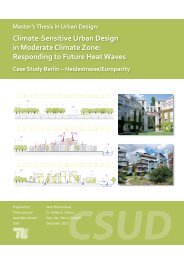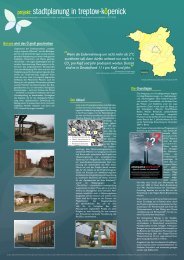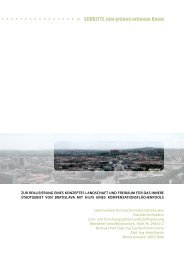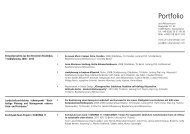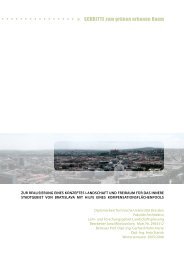Bausteine - Referate - Jana Milosovicova - Urban Design English
Bausteine - Referate - Jana Milosovicova - Urban Design English
Bausteine - Referate - Jana Milosovicova - Urban Design English
Erfolgreiche ePaper selbst erstellen
Machen Sie aus Ihren PDF Publikationen ein blätterbares Flipbook mit unserer einzigartigen Google optimierten e-Paper Software.
Bebauungsplan, or “B-plan.” Germany has 10<br />
zoning districts: classified as residential, mixeduse,<br />
commercial and special. In the residential<br />
and mixed-use districts, local commercial is<br />
permitted (either by right or conditional) and<br />
required, respectively. (See Table 1) As a result,<br />
most areas have varying levels of mixed-use.<br />
The “B-plan” is a legally binding local plan that<br />
regulates the specific type and degree of building<br />
and land use. Typically initiated by the local<br />
planning authority, B-plans usually cover an area<br />
from block to several blocks. In locations without<br />
a B-Plan, the use of the property is regulated<br />
by the underlying zoning and must generally<br />
match the surrounding uses in the direct area.<br />
In comparison to American regulations, B-Plans<br />
are most similar to the regulating plans used in<br />
form-based codes and planned unit development<br />
ordinances that also have greater detail at<br />
the block and building level.<br />
The American planning system is characterized<br />
by strong local planning control. The only federal<br />
involvement was the 1921 zoning enabling<br />
act that authorized local governments to divide<br />
territory into districts. As a result, the dominating<br />
land use regulation in the U.S. is the unique<br />
zoning code of each municipality. Despite some<br />
variety between codes, most suburban codes<br />
include strictly separated uses, low permissible<br />
housing densities, large building setbacks and<br />
high minimum parking requirements. Efforts at<br />
increasing mixed-use have include new mixeduse<br />
zones, new form-based code zones (that<br />
allow a rezoning from the old code to the new<br />
code), and occasionally rewrites of entire zoning<br />
codes.<br />
Transportation Planning<br />
Public policy in Germany has supported walking,<br />
bicycling and transit use with increased funding<br />
and infrastructure while restricting automobile<br />
use mainly through high taxes. Metropolitan<br />
wide transit systems are standard, with large<br />
subsidies that enable high-quality service for<br />
low ticket prices. However, German has levels<br />
of automobile ownership only 10 percent lower<br />
than the U.S. and an extensive autobahn<br />
system between cities. Yet transit use has increased<br />
in a case study of three cities, Muenster,<br />
Freiburg and Munich due in part to major improvements<br />
in public transit systems and bicycle<br />
networks. In Munich public transit rose from 19<br />
percent in 1976 to 25 percent in 1995; bicycling<br />
doubled from 6 percent to 14 percent. Freiburg<br />
showed similar results between 1976 and 1994:<br />
transit use rose from 22 percent to 26 percent,<br />
bicycling rose from 18 percent to 28 percent,<br />
and the share of automobile travel fell from 60<br />
percent to 46 percent (TCRP, 1998).<br />
After 50 years of highway building, most U.S.<br />
cities are now car dependant. Transportation<br />
is funded primarily from gas and vehicle taxes<br />
(TCRP, 1998) with 80 percent dedicated to<br />
highways and roads and 17 percent for transit<br />
(Farr, 2008). In the U.S., transit expansion is<br />
in planning stages or underway in most major<br />
metropolitan areas. Federal funds for transit are<br />
limited so transit projects line up and “wait in<br />
line” for several years before receiving funding<br />
in a competitive process. In response to gas prices<br />
rising over 2007, American transit use had<br />
the highest number of rides taken in 50 years.<br />
(APTA, 2008)<br />
The Role of the Rating System<br />
In Germany, the city has a much stronger role<br />
in the development process than in the U.S.,<br />
with the ability to shape development more<br />
closely through the B-Plan process and more<br />
active participation in the buying and selling of<br />
land it wants to have developed. Public-private<br />
partnerships are also much more common in<br />
Germany as governments take an active role<br />
in shaping development. In the U.S., the private<br />
sector tends to take a lead role, with greater<br />
involvement in the planning process and local<br />
infrastrucature layout.<br />
Continuing to create auto-dependant areas will<br />
only increase carbon dioxide emissions; addressing<br />
sprawl is necessary to reduce the emissions<br />
that cause climate change. Yet both Europe and<br />
America need to align government and market<br />
101



